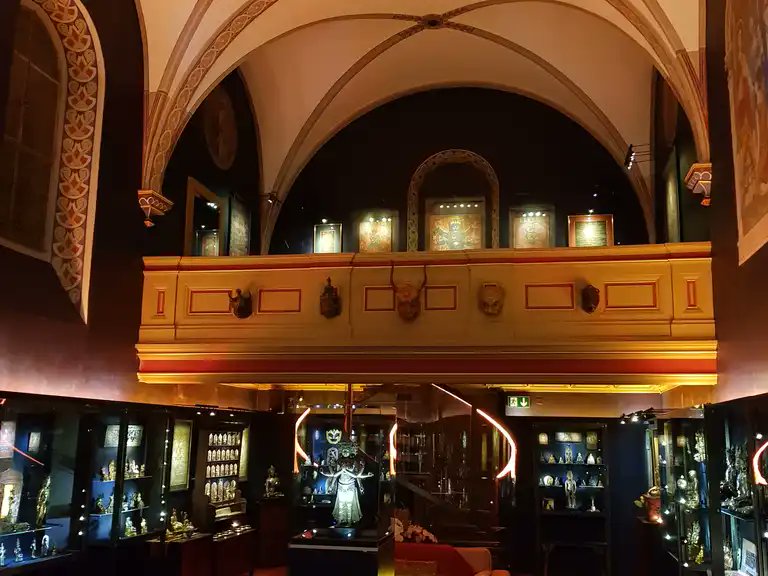
The Metropolitan Museum says this head was carved in the 6th century BCE. I think it was made in Greece in the early 20th century. Why? Let me explain... 

The man on the right in this 1895 photo is John Marshall. From 1905-1928, the Met Museum paid him to buy antiquities for them in Europe. His archives, with info about many of these purchases, were just put online last November (thanks, British School at Rome!). 



(Side note that the man on the left is Edward Perry Warren. Marshall was his secretary. They lived together and had matching dogs and signed their letters to each other "Puppy." Later, Marshall married Warren's cousin. They're all buried together. (Not the dogs.)) 

On February 14, 1909, Marshall wrote to Edward Robinson, assistant director of the Met, excitedly reporting on "an archaic Apollo for sale at Athens." The Met didn't buy it, probably because someone (maybe Gisela Richter) identified it as a pastiche of two existing sculptures. 

If you overlap the photo with the Melos Kouros (c. 550 BCE, discovered in 1891 and now in the Athens National Museum), you see it's pretty much an exact copy. 

The head is harder to see in the photo, but the fringe of hair on its forehead doesn't look like the Melos Kouros - instead, it resembles another sculpture in the Athens National Museum, the Volomandra Kouros (560-550 BCE, discovered in 1901). 



I think the sculpture in the 1909 photograph from Marshall's archive is a fake - a pastiche combination of the Melos and Volomandra sculptures, which would have been easy enough to do using a pantograph or other form of mechanical pointing and sizing from plaster casts. 



I started wondering what became of this 1909 sculpture. If the seller(s) in Athens couldn't find a buyer for the whole thing, might they have tried again by dividing it into parts? I remembered the Met's head... 

Marshall bought the head in 1921 for the Met from Michel L. Kambanis, an Athenian dealer. Here's Marshall's inventory card. 

The head is pretty beat up and looks kinda weird. Previous scholars have condemned it as fake, but the Met's curators have said no, it was just treated with acid and recarved in modern times - hence the extra lines around the eyes and the truly unfortunate duck lips. 





Met curators also point out the similarity of the face and hair to the Volomandra Kouros. As you see from my overlapping photos, they are similar but by not means identical. But... 





If you float the Met head over the 1909 photo, it's exact - down to the number and arrangement of the locks of hair. 



My guess is that sometime between 1901 and 1909, a forger made a full-body sculpture by combining two ancient models. When that failed to sell, someone cut off its head and hacked it up enough to disguise it from buyers like Marshall who had already seen a photo of the whole. 

I tweeted about the Met's famed kouros sculpture earlier today: 



https://twitter.com/artcrimeprof/status/1621578931857137665?s=20&t=M1AqIYfFbinrCq9qOLi5fw. He's also close to two different ancient sculptures: his body closely resembles the Sounion A Kouros (found 1906) and his head the Dipylon Head (found 1911).




Being similar isn't a sure sign of forgery, of course. More worrying is something Vinzenz Brinkmann noticed in a 2017 publication: the Met kouros' hair is of an anachronistic shape. Brinkmann thinks he must have been repainted 100 years later. But... 



... the near-perfect preservation of the Met sculpture has always been explained by the theory he was buried relatively soon after he was carved. How can that fit with 100 years of weathering while waiting for a new manscaping style? 

Another very interesting detail: the height of the 1909 sculpture, as recorded in Marshall's letter, is a centimeter less that the height of the Met kouros. 

Did our forger, frustrated in 1909, get enough inspiration from the new discovery of the Dipylon Head in 1911 to try again? The Met paid $150,000 for their kouros in 1932 ($2.6 million today) - a powerful incentive! 

I'd be very glad to hear any thoughts one way or the other, on any of these sculptures - thank you in advance!
• • •
Missing some Tweet in this thread? You can try to
force a refresh

























